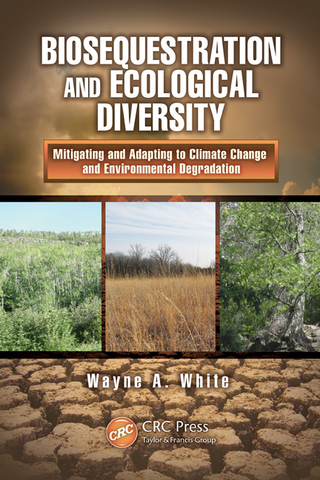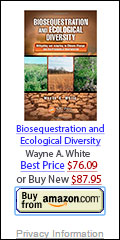Also See: Editor's Note, Endorsements, and Purchase Information

TABLE OF CONTENTS
-
INTRODUCTION
CHAPTER ONE: GLOBAL WARMING AND ECOLOGICAL DEGRADATION
EMERGENCE OF THE ANTHROPOCENE
Ecological Constraints
CLIMATE CHANGE AS CONTEXT
Climate Inertia
AN OVERVIEW OF CLIMATE CHANGE EVIDENCE
Natural Factors and Denial
Uncertainties Remain
The Relative Impact of Natural and Anthropogenic Factors
Long-term Cycles and Rate of Warming
CARBON DIOXIDE AND RADIATIVE FORCING
Human Impacts Recently Overwhelmed Natural Factors
Radiative Forcing
The Paradox of Aerosols
CLIMATE SENSITIVITY: THE LIKELY EXTENT AND RATE OF WARMING
The Uses and Limitations of Climate Models
THE ECOSYSTEM IMPACTS OF GLOBAL WARMING AND RELATED ECOLOGICAL CRISES
Marine Ecosystems
Terrestrial Ecosystems and Complex Ecological Interactions
Ecological Change at the Poles
Vector Borne Disease and Beetle Population Explosions
Biodiversity Loss
PRELUDE TO A STRATEGY
ENDNOTES
CHAPTER 2: THE GLOBAL CARBON CYCLE AND TERRESTRIAL BIOSEQUESTRATION
TERRESTRIAL ECOSYSTEMS AND THE CARBON CYCLE IMBALANCE
Introduction
Buying Time
Adapting
An Unplanned Global Geophysical Experiment
Rate of Change
Carbon Reservoirs and Flux: From Stability to Imbalance
ENHANCED CARBON SEQUESTRATION
Carbon Capture and Storage Technologies
Terrestrial Biosequestration
Overview of Established Land Use and Management Strategies
New and Developing Technologies for Enhanced Terrestrial Sequestration
THE PROBLEM OF PERMANENCE
ENDNOTES
CHAPTER 3: TERRESTRIAL CARBON, FOOD SECURITY AND BIOSEQUESTRATION ENHANCEMENT
LAND AND CARBON MANAGEMENT
FOREST BIOMES AND CARBON SINKS
Boreal Forests
Temperate Forests
Tropical Forests
A Precarious Improvement
Tropical Deforestation and Fossil Fuel Emissions
Ecological Restoration
AGRICULTURAL LAND, DEGRADED SOILS AND WATER SCARCITY
Restoring Carbon to Agricultural Soils
Cropland, Grazing Land, Water, Population and Food
Wetlands, Peatlands and Aquatic Ecosystems
FOOD SECURITY
BEYOND EMISSIONS
A CONSERVATIVE ESTIMATE OF GLOBAL TERRESTRIAL CARBON BIOSEQUESTRATION ENHANCEMENT
ENDNOTES
CHAPTER 5: CONSERVATION POLICY AND THE POLITICS OF GROWTH
LAND MANAGEMENT FOR CARBON BIOSEQUESTRATION AND ECOLOGICAL DIVERSITY
Canadian Boreal Forest
Northeast Kansas Grassland and Homestead
Biofuels in Ecological Context
Displacing Coal with Biomass Energy from High Diversity Grassland Species
Kansas Woodland
Mature Lower Michigan Deciduous Forest
Toward Grain and Oilseed Perennialism
Food Production with Existing Best Practices
Agroforestry and Reforestation in the Sahel
CONCRETE STEPS AND A VISION
ENDNOTES
CHAPTER 4: LAND MANAGEMENT EXAMPLES, PRACTICES AND PRINCIPLES
CONSERVATION ASSISTANCE IS AVAILABLE
SOCIETAL TRANSFORMATION AND THE POLITICS OF GROWTH
From Degradation to Restoration
A Sense of Urgency
Changing the Energy System and Infrastructure
The Limitations of International Regulatory Frameworks
Local Action and a New Relationship with Nature
The Growth Dilemma and Globalization
A New Economics and the Politics of Denial
ENDNOTES
Editor's Note for the "CRC Press" Book Series, Social-Environmental Sustainability:
In the introduction to this book, Wayne relates the story of a banker in Kansas who, "as a father and grandfather," was seriously concerned about the available supply of water and the concomitant economy 30 years into the future, but, as an officer of the bank, "he had a fiduciary responsibility to maximize revenue in the current and next fiscal years." He saw his job constrained by the aphorism, "success in business comes from working on the things that you can control." Left unsaid in this statement is the practical fact that our social life is under the relentless tutelage of an economic system, the premise of which is dissatisfaction with one's present standard of living, supported by an army of advertisers who espouse the constant need for ever-greater acquisition—for more, always more.
Consequently, our economic system is based on symptomatic thinking focused solely on quick fixes to anything threatening economic expansion and the linear growth of profits. This pattern of thinking, left unchecked, is rapidly altering the global ecosystem in a way that makes much of it progressively less conducive to human habitation—a situation compounded not only by a bourgeoning human population but also by the increased longevity of human life.
Moreover, we must think systemically about the three interactive spheres that comprise our world: the atmosphere (air), the litho-hydrosphere (the rock that constitutes the restless continents and the water that surrounds them), and the biosphere (the life forms that exist within the other two spheres). Although social-environmental sustainability requires systemic thinking, we arbitrarily delineate our seamless world into discrete ecosystems nonetheless, as we try to understand the fluid interactions between nonliving and living components of Earth. But, if you picture the interconnectivity of the 3 spheres as being analogous to the motion of a filled waterbed, you will see how patently impossible such divisions are because you cannot touch any part of a waterbed without affecting the whole of it.
Consequently, there are no problems "out there." The environment is a simply a biophysical mirror reflecting our chronic, social-economic dysfunction, which is now reaching a critical stage with increasing portends of terminal conditions for supporting human life in the decades and centuries to come in more and larger portions of the global ecosystem.
Is this outcome inevitable? Is there nothing we can do to avert it?
No, it is not inevitable, and yes, we can avert it, but we must act now—decisively and collectively. I emphasize now because this eternal moment—the here and now—is all we have or ever will have. As Wayne illustrates in his book, "There are many ways to reduce greenhouse gas emissions and some fascinating ways to remove them from the atmosphere by changing the way we use and manage land."
To accomplish this, however, we must ground our culturally designed landscapes and seascapes within nature's evolved patterns and take advantage of them if we are to have a chance of creating a quality environment that is both pleasing to our cultural senses and biophysically sustainable. To wit, we must do three primary things: (1) control our human population, (2) refocus our concept of development from the exploitive, symptomatic subjugation of nature to a harmonious, systemic cultural evolution of sustainability with nature, and (3) protect existing biodiversity—including habitats and biophysical processes—at any price for the long-term sustainability of the ecological wholeness and the biological richness of the patterns we create across our global landscapes and seascapes.
For a nation and world that is increasing governed by symptomatic thinking, despite to the world's systemic nature, Wayne's book is an important voice in support of a rising global consciousness with respect to protecting and nurturing nature's free services for all generations—rather than simply exploiting them for immediate, personal gain. To this end, he explains how greenhouse gases can be withdrawn from the atmosphere and isolated over time in both land and oceans through a process known as "biosequestration."This process can be thought of as long-term storage accomplished by honoring the biophysical principles through which nature operates. Wayne's message is clear and gentle, yet profound in its simplicity: By working in harmony with nature, we not only begin to heal the damage we humans have cause by degrading the global ecosystem over the centuries but also begin to heal ourselves by accepting our role as trustees of Earth as a biological living trust—of which all generations are the beneficiaries.
This book makes an important contribution to the series on social-environmental sustainability by offering an excellent blueprint of the systemic components and actions necessary to commence a conscious, collective process of healing our home planet, each within our own capacity. The choice of accepting and acting on the wisdom contained within these covers belongs to us, the adults of the world. The consequences of our decisions, however, we bequeath all generations—for better or worse. How shall we choose?
Chris Maser, Series Editor
(Return to Top of Page)
Endorsements:
"Written for students, researchers, and academics involved in environmental and social sciences, as well as land owners and managers, this reference is the first of its kind to cover biosequestration for a broad audience. The author covers the scientific evidence of biosequestration, the various land practices that sequester carbon, and policies in place to encourage such practices. It includes examples of actions taken by the author that can be used by gardeners, farmers, ranchers, and those in land management. It also focuses on several issues of importance: global warming, carbon pollution, sustainable agriculture, ecological problems of conventional agriculture, and land management."—Publisher's description.
"… shines a spotlight on a topic that has not received sufficient attention in the growing literature on global climate change. … The picture is a frightening one. … But, the author also provides a way forward by documenting the ways in which greenhouse gases can be removed from the atmosphere through restorative land management practices. … The author's ability to make a complicated subject accessible to the general reader makes for a great blueprint for combating climate change."
Dr. Eric Hanley
Professor, Department of Sociology
The University of Kansas
Lawrence, KS
"Lucidly and succinctly, Wayne Allan White guides the reader through the scientific complexities of climate change and its environmental impacts. Although with a sense of urgency about the serious ecological threats at hand, his conviction that something can and should be done about these problems animates the work. … This illuminating work will be accessible to a wide range of readers interested in climate change and the emergent ecological crisis."
Dr. Robert J. Antonio
Professor, Department of Sociology
The University of Kansas
Lawrence, KS
"… both a solemn reminder of the trouble we're in and a hopeful treatise on sustainable possibilities that await us when we decide to act. Well-crafted and empirically rich, this superb book gives us an intelligent assessment of the ecological and social conditions that constitute the all too real problem of climate change."
Dr. Michael Carolan
Chair, Department of Sociology
Colorado State University
Fort Collins, CO
(Return to Top of Page)
Purchase Information:
